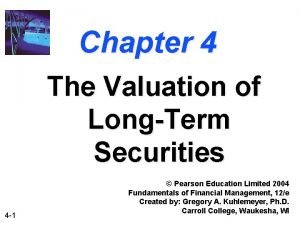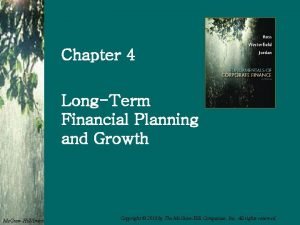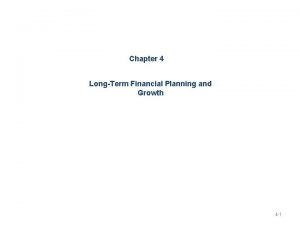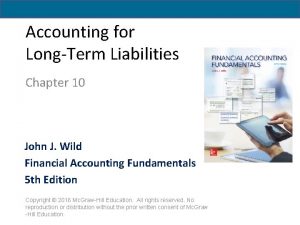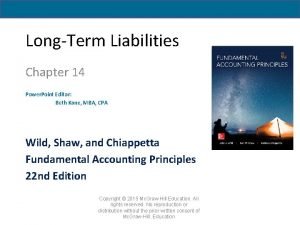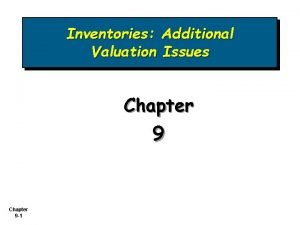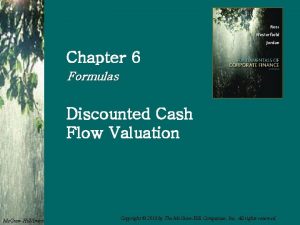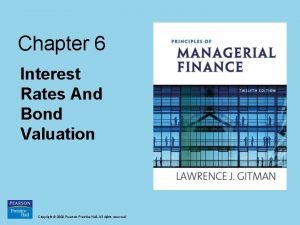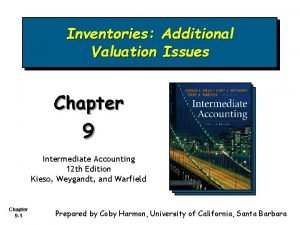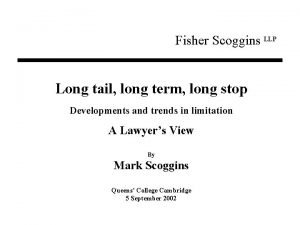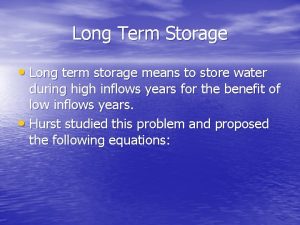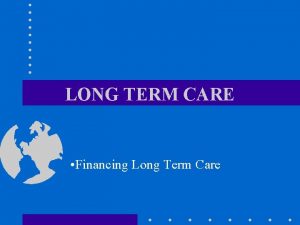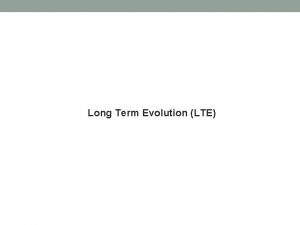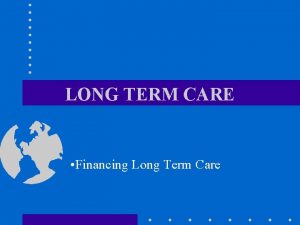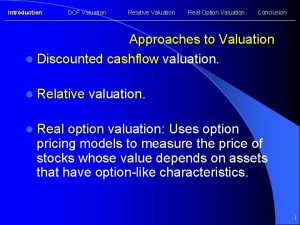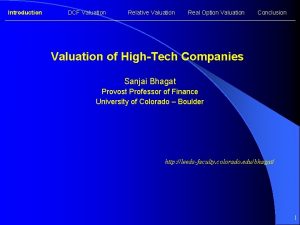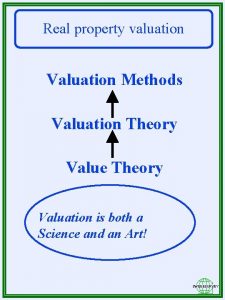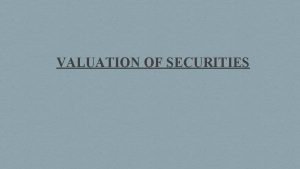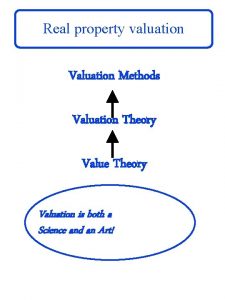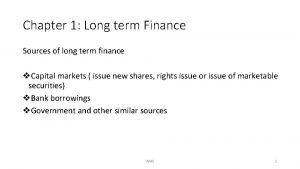Chapter 4 Support The Valuation of Long Term























- Slides: 23

Chapter 4 – Support The Valuation of Long -Term Securities 4 b. 1 Van Horne and Wachowicz, Fundamentals of Financial Management, 13 th edition. © Pearson Education Limited 2009. Created by Gregory Kuhlemeyer.

Remember? Coupon Bond Example Bond C has a $1, 000 face value and provides an 8% annual coupon for 30 years. The appropriate discount rate is 10%. What is the value of the coupon bond? Where V = $811 (rounded answer) Well, we can use our knowledge of TVM from Chapter 3. The value of a bond has been shown to be the present value of the coupon payments (an annuity) and the future maturity value. Refer to ‘VW 13 E-04. xlsx’ on the ‘Bond Valuation’ tab. 4 b. 2 Van Horne and Wachowicz, Fundamentals of Financial Management, 13 th edition. © Pearson Education Limited 2009. Created by Gregory Kuhlemeyer.

Coupon Bond Example Students should notice that the valuation is exactly the same as other accurate methods to solve and can be solved in one step in Excel using ‘=pv(. 1, 30, 80, 1000)’. Refer to ‘VW 13 E-04. xlsx’ on the ‘Bond Valuation’ tab. 4 b. 3 Van Horne and Wachowicz, Fundamentals of Financial Management, 13 th edition. © Pearson Education Limited 2009. Created by Gregory Kuhlemeyer.

Remember? Zero-Coupon Bond Example Bond Z has a $1, 000 face value and a 30 year life. The appropriate discount rate is 10%. What is the value of the zero-coupon bond? … V = $57. 00 (rounded answer). This is the same type of problem once again, EXCEPT there is no annuity cash flow! It is simply a straight PV -type problem of finding the PV of the maturity value. We can place a value of $0 in the payment cell. Refer to ‘VW 13 E-04. xlsx’ on the ‘Bond Valuation’ tab. 4 Van Horne and Wachowicz, Fundamentals of Financial Management, 13 th edition. © Pearson Education Limited 2009. Created by Gregory Kuhlemeyer.

Zero-Coupon Bond Example Students should notice that the valuation is again exactly the same as other accurate methods and can be solved in one step using ‘= pv(. 1, 30, 0, 1000)’. Refer to ‘VW 13 E-04. xlsx’ on the ‘Bond Valuation’ tab. 4 b. 5 Van Horne and Wachowicz, Fundamentals of Financial Management, 13 th edition. © Pearson Education Limited 2009. Created by Gregory Kuhlemeyer.

Remember? Semiannual Compounding Most bonds in the US pay interest twice a year (1/2 of the annual coupon). Adjustments needed: (1) Divide kd by 2 (2) Multiply n by 2 (3) Divide I by 2 4 b. 6 Van Horne and Wachowicz, Fundamentals of Financial Management, 13 th edition. © Pearson Education Limited 2009. Created by Gregory Kuhlemeyer.

Semiannual Coupon Bond Example • Bond C was purchased on 12 -31 -2009 and will be redeemed on 12 -31 -2024. This is identical to the 15 year period we discussed for Bond C. • It is an American-style and pays its annual coupon interest semiannually. The stated coupon rate is 7%. • The US economy has recently been struggling and market interest rates have fallen to 5. 5%. • You expect to hold the bond to maturity to redeem the $1, 000 face amount. • What is the value of this bond? 4 b. 7 Van Horne and Wachowicz, Fundamentals of Financial Management, 13 th edition. © Pearson Education Limited 2009. Created by Gregory Kuhlemeyer.

Semiannual Coupon Bond Example Students should notice that we have adjusted the rate, nper and pmt values in the semiannual problem. Again, this can be solved in one step using ‘= pv(. 0275, 30, 35, 1000)’. Refer to ‘VW 13 E-04. xlsx’ on the ‘Bond Valuation’ tab. 4 b. 8 Van Horne and Wachowicz, Fundamentals of Financial Management, 13 th edition. © Pearson Education Limited 2009. Created by Gregory Kuhlemeyer.

Remember? Preferred Stock Example Stock PS has an 8%, $100 par value issue outstanding. The appropriate discount rate is 10%. What is the value of the preferred stock? stock … V = $80. Students should recall that perpetuities such as preferred stock can be generally solved with a simple calculator solution (cash flow divided by required rate of return). We will briefly review. Refer to ‘VW 13 E-04. xlsx’ on the ‘PS Valuation’ tab. 4 b. 9 Van Horne and Wachowicz, Fundamentals of Financial Management, 13 th edition. © Pearson Education Limited 2009. Created by Gregory Kuhlemeyer.

Preferred Stock Example Students should notice that we have adjusted the rate, nper and pmt values in the semiannual problem. Again, this can be solved in one step using ‘=pv(. 1, 3000, 8)’ or simple ‘=8/. 1’ Refer to ‘VW 13 E-04. xlsx’ on the ‘Bond Valuation’ tab. 4 b. 10 Van Horne and Wachowicz, Fundamentals of Financial Management, 13 th edition. © Pearson Education Limited 2009. Created by Gregory Kuhlemeyer.

Remember? Growth Phases Model Example Stock GP has an expected growth rate of 16% for the first 3 years and 8% thereafter. Each share of stock just received an annual $3. 24 dividend per share. The appropriate discount rate is 15%. What is the value of the common stock under this scenario? 4 b. 11 Van Horne and Wachowicz, Fundamentals of Financial Management, 13 th edition. © Pearson Education Limited 2009. Created by Gregory Kuhlemeyer.

Common Stock Example The above information provides the inputs into the process. This may be confusing for this problem as the. xlsx file is designed to provide limited flexibility to the student in valuing these types of problems. As such, since there is only two phases the third phase has the same growth rate as the second and will not alter the value. Refer to ‘VW 13 E-04. xlsx’ on the ‘Growth Phases’ tab. 4 b. 12 Van Horne and Wachowicz, Fundamentals of Financial Management, 13 th edition. © Pearson Education Limited 2009. Created by Gregory Kuhlemeyer.

Common Stock Example • The first step is to calculate all of the forecasted dividends. You will need to calculate one more forecasted dividend than the sum of periods in the first two phases (cells D 5 and D 7). In this example, we will need to estimate 10 (3 + 6 + 1). • While the reality of designing your own sheet would only require four (three from phase 1 plus the following dividend), you will see the flexibility momentarily. • Refer to ‘VW 13 E-04. xlsx’ on the ‘Growth Phases’ tab. 4 b. 13 Van Horne and Wachowicz, Fundamentals of Financial Management, 13 th edition. © Pearson Education Limited 2009. Created by Gregory Kuhlemeyer.

Common Stock Example • The second step is to calculate all of the forecasted cash flows. You will notice that this differs as the last cash flow represents an estimate of what you will sell the asset for at the end of the second phase. • Since the stock is assumed to be growing at a constant rate forever after the second phase, we use the constant growth model to estimate that value. V 9 = D 10/(k-g 3) = 8. 66733/(. 15 -. 08) = $123. 81. The cash flow in period 9 is then $8. 03+$123. 81=$131. 84. • Refer to ‘VW 13 E-04. xlsx’ on the ‘Growth Phases’ tab. 4 b. 14 Van Horne and Wachowicz, Fundamentals of Financial Management, 13 th edition. © Pearson Education Limited 2009. Created by Gregory Kuhlemeyer.

Common Stock Example • Now use the NPV function to find the PV of the cash flows from periods 1 through 9. • This is simple to use as is seen in the formula listed in cell F 12 which refers to the cash flows in cells D 27: E 35 (merged cells were used for viewing only or it would be a simple array) and discounting at the 15% rate of cell D 10. • Refer to ‘VW 13 E-04. xlsx’ on the ‘Growth Phases’ tab. 4 b. 15 Van Horne and Wachowicz, Fundamentals of Financial Management, 13 th edition. © Pearson Education Limited 2009. Created by Gregory Kuhlemeyer.

Redo! Growth Phases Model Example • NOW ASSUME: Stock GP 2 has an expected growth rate of 24% for the first 3 years, 16% for the next 6 years and 8% thereafter. Each share of stock just received an annual $3. 24 dividend per share. The appropriate discount rate is still 15%. What is the value of the common stock under this scenario? • So we are only increasing the growth rate in the first 9 years of an infinitely-lived asset. • What impact does it have on valuation today? 4 b. 16 Van Horne and Wachowicz, Fundamentals of Financial Management, 13 th edition. © Pearson Education Limited 2009. Created by Gregory Kuhlemeyer.

Common Stock Example • Now the stock GP 2 is worth $102. 45 rather than $61. 19 for GP. That is an astounding 67. 4% increase in the stock price because you assumed that dividends would grow at a rate that is only 8% higher for only the first nine years! • Now we see why investors listen so closely to determine how earnings for a firm are growing or not right now! • Refer to ‘VW 13 E-04. xlsx’ on the ‘Growth Phases’ tab. 4 b. 17 Van Horne and Wachowicz, Fundamentals of Financial Management, 13 th edition. © Pearson Education Limited 2009. Created by Gregory Kuhlemeyer.

Redo! Growth Phases Model Example • NOW ASSUME: Stock GP 3 has an expected growth rate of 8% for the first 3 years, 10% for the next 6 years and 12% thereafter. Each share of stock just received an annual $3. 24 dividend per share. The appropriate discount rate is still 15%. What is the value of the common stock under this scenario? • So we are only increasing the growth rate in the first 9 years of an infinitely-lived asset. • What impact does it have on valuation today? 4 b. 18 Van Horne and Wachowicz, Fundamentals of Financial Management, 13 th edition. © Pearson Education Limited 2009. Created by Gregory Kuhlemeyer.

Common Stock Example • Now the stock GP 3 is worth $99. 14 rather than $61. 19 for GP and $102. 45 for GP 2. Yet this stock is not as highly valued as GP 2 even though for years 10 through infinity it is growing 4% faster (from 8% to 12%)! • So it is important to grow fast in the short-term as well as the long-term with a goal of MAXIMIZING SHAREHOLDER WEALTH! • Refer to ‘VW 13 E-04. xlsx’ on the ‘Growth Phases’ tab. 4 b. 19 Van Horne and Wachowicz, Fundamentals of Financial Management, 13 th edition. © Pearson Education Limited 2009. Created by Gregory Kuhlemeyer.

Remember? Determining the YTM Julie Miller want to determine the YTM for an issue of outstanding bonds at Basket Wonders (BW). BW has an issue of 10% annual coupon bonds with 15 years left to maturity. The bonds have a current market value of $1, 250 We can find the YTM in Excel also! 4 b. 20 Van Horne and Wachowicz, Fundamentals of Financial Management, 13 th edition. © Pearson Education Limited 2009. Created by Gregory Kuhlemeyer.

Bond YTM Example • Similar to TVM, we will use the RATE function to solve this problem. • A critical item is to note that your cash inflows and outflows must be signed properly. We are assuming here that you are an investor purchasing the bond • The YTM is 7. 22% which is the same answer as before. Since this rate is less than the coupon rate, it explains why this bond is selling at a premium. • Refer to ‘VW 13 E-04. xlsx’ on the ‘YTM’ tab. 4 b. 21 Van Horne and Wachowicz, Fundamentals of Financial Management, 13 th edition. © Pearson Education Limited 2009. Created by Gregory Kuhlemeyer.

Remember? Determining Semiannual YTM Julie Miller want to determine the YTM for another issue of outstanding bonds. The firm has an issue of 8% semiannual coupon bonds with 20 years left to maturity. The bonds have a current market value of $950 What is the YTM? [ 1 + (. 0852514 / 2)2 ] -1 = 0. 0871 or 8. 71% (same result!) 4 b. 22 Van Horne and Wachowicz, Fundamentals of Financial Management, 13 th edition. © Pearson Education Limited 2009. Created by Gregory Kuhlemeyer.

Bond YTM Example • Just like the last problem, we calculate the YTM period. • We have one further step here and that is to annualize the answer for compunding (see cell F 10 for the formula) • The YTM is 8. 71% which is the same answer as before. Since this rate exceeds the coupon rate, it explains why this bond is selling at a discount. • Refer to ‘VW 13 E-04. xlsx’ on the ‘YTM’ tab. 4 b. 23 Van Horne and Wachowicz, Fundamentals of Financial Management, 13 th edition. © Pearson Education Limited 2009. Created by Gregory Kuhlemeyer.
 Valuation of long term securities
Valuation of long term securities Fixed income valuation methods
Fixed income valuation methods Short medium and long term planning in education
Short medium and long term planning in education Long term memory vs short term memory
Long term memory vs short term memory Short term human resources examples
Short term human resources examples Difference between long term and short term liabilities
Difference between long term and short term liabilities Difference between long term and short term liabilities
Difference between long term and short term liabilities Long-term goals
Long-term goals Short-term financial management
Short-term financial management Tall+short h
Tall+short h Once upon a time there lived a little
Once upon a time there lived a little Từ ngữ thể hiện lòng nhân hậu
Từ ngữ thể hiện lòng nhân hậu Property valuation certificate by chartered accountant
Property valuation certificate by chartered accountant Long term financial planning and growth chapter 4
Long term financial planning and growth chapter 4 Sustainable growth rate
Sustainable growth rate Chapter 10 accounting for long term liabilities
Chapter 10 accounting for long term liabilities Chapter 14 long term liabilities
Chapter 14 long term liabilities Major details
Major details Chapter 7 interest rates and bond valuation
Chapter 7 interest rates and bond valuation Chapter 9 inventories additional valuation issues
Chapter 9 inventories additional valuation issues Chapter 6 discounted cash flow valuation
Chapter 6 discounted cash flow valuation How to find the price of a bond
How to find the price of a bond Chapter 6 interest rates and bond valuation
Chapter 6 interest rates and bond valuation Lower of cost or market rule
Lower of cost or market rule
